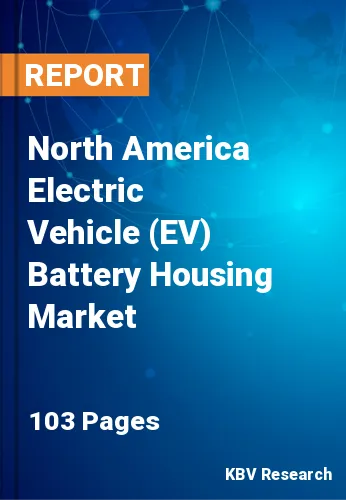The North America Electric Vehicle (EV) Battery Housing Market would witness market growth of 12.9% CAGR during the forecast period (2023-2030).
Modular and scalable designs are gaining prominence in the market. Modular architectures allow flexibility in adapting to different vehicle models, sizes, and configurations. Scalable designs enable manufacturers to use standardized components across various vehicle platforms, streamlining production and reducing costs. The integration of smart technologies into EV battery housing is a notable trend. Smart features include real-time monitoring, predictive maintenance, and over-the-air updates. These technologies enhance overall performance, safety, and longevity by providing valuable data and insights into battery health and usage patterns.
The Integration of 5G connectivity and communication capabilities Is emerging as a trend In EV battery housing. This allows for real-time data transfer, remote diagnostics, and software updates, enhancing the connectivity and functionality of electric vehicles. Innovations in safety features focus on minimizing risks associated with lithium-ion batteries. Enhanced safety measures in EV battery housing include robust designs, impact-absorbing structures, and fire-resistant materials. These innovations contribute to meeting stringent safety standards and building consumer confidence in electric vehicles.
As per the International Trade Administration (ITA), the automotive industry in the United States is one of the largest globally. In the United States, 14.5 million light vehicles were sold in 2020. The global push for electric mobility influences the decisions of both consumers and automakers in Mexico. As per the International Trade Administration, Mexico City is the world's fifth most populous city, with 21 million people and 33.4 million vehicles. In 2018, Mexico recorded a 68 percent increase in EV sales, and hybrid vehicle sales surpassed 17,800 units compared to 2017. 955,393 electric and hybrid vehicles were sold in 2019 from January through September. Therefore, the factors mentioned above will drive the regional market growth.
The US market dominated the North America Electric Vehicle (EV) Battery Housing Market by Country in 2022, and would continue to be a dominant market till 2030; thereby, achieving a market value of $3,559.8 Million by 2030. The Canada market is experiencing a CAGR of 15.5% during (2023 - 2030). Additionally, The Mexico market would exhibit a CAGR of 14.5% during (2023 - 2030).
Free Valuable Insights: The Electric Vehicle (EV) Battery Housing Market is Predict to reach $24.3 Billion by 2030, at a CAGR of 13.2%
Based on Vehicle Type, the market is segmented into Passenger Car and Commercial Car. Based on Material, the market is segmented into Aluminium, Steel and Others (Carbon Fibre & Carbon Glass). Based on countries, the market is segmented into U.S., Mexico, Canada, and Rest of North America.
By Vehicle Type
By Material
By Country
Our team of dedicated experts can provide you with attractive expansion opportunities for your business.

